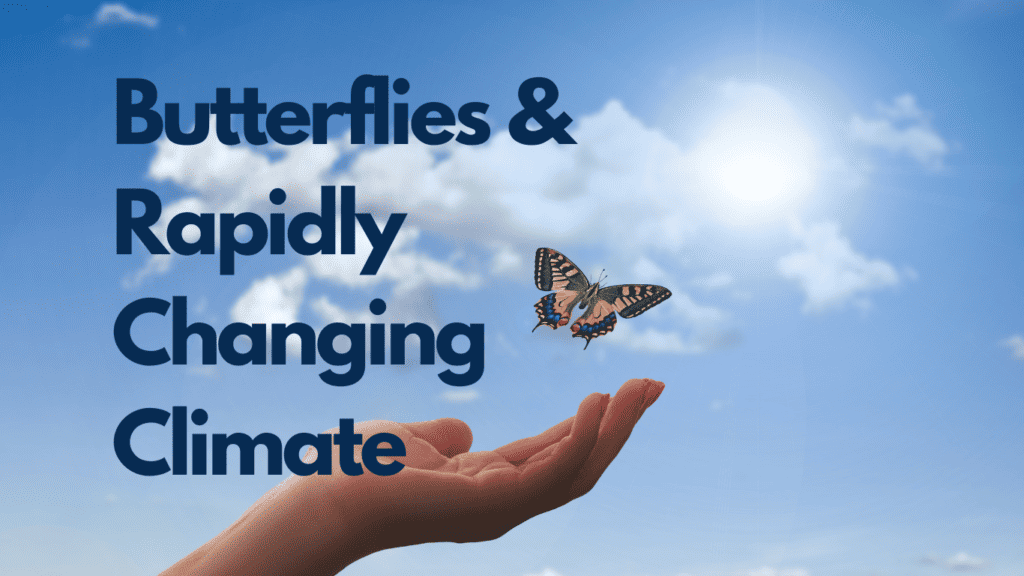Butterflies are not just beautiful creatures; they are also masters of adaptation. Faced with the challenges of climate change, many species have been observed shifting their habitats to cooler, shaded areas. However, this isn’t enough to protect the entire species, making it a pressing concern for conservationists.
Butterflies and Climate Change: From altering their life cycles to take advantage of warmer temperatures, to changing migration patterns, butterflies employ various strategies to survive. They even adapt to new host plants, like the monarch butterfly’s switch to different species of milkweed. Despite these efforts, the rapid pace of climate change may outstrip their ability to adapt, emphasizing the need for urgent conservation measures.
Butterfly Adaptations

Wing Patterns and Colors
Butterflies have developed unique wing patterns and colors that help them blend into their surroundings and protect them from predators. These adaptations can be both physical and behavioral. Physical adaptations (aka structural adaptations) of butterflies include their wing patterns which help them to camouflage.
Camouflage and Mimicry
Butterflies use their wing patterns to blend into their environment and avoid being seen by predators. Some butterflies have evolved to mimic other species that are toxic or unpalatable to predators. This helps them avoid being eaten.
Proboscis and Feeding
Butterflies have a long proboscis that they use to feed on nectar from flowers. This adaptation allows them to reach deep into flowers to access the nectar. Some species of butterflies have adapted to feed on other sources of food, such as rotting fruit.
Metamorphosis and Transformation
Butterflies undergo a remarkable transformation from a caterpillar to an adult butterfly. This process, known as metamorphosis, allows the butterfly to adapt to its environment and protect itself from predators. During metamorphosis, the caterpillar transforms into a chrysalis, and then into an adult butterfly.
Butterflies and Their Environment
Sensitivity to Environmental Cues
Butterflies are highly sensitive to environmental cues, such as temperature, humidity, and light. These cues can affect their behavior, development, and survival. For example, some species of butterflies can only mate when the temperature is within a certain range. Others can only lay their eggs on specific types of plants that grow in certain habitats.
Adaptation to Cooler Areas
Butterflies have adapted to cooler areas by developing specialized mechanisms to regulate their body temperature. Some species have wings that are darker on the upper surface, which allows them to absorb more heat from the sun. Others have hairs on their wings that trap air and insulate their bodies. Some species also hibernate during the winter, while others migrate to warmer climates.
Backyard Habitats
Butterflies can thrive in backyard habitats if they are provided with the right conditions. This includes planting native plants that provide food and shelter, providing a water source, and avoiding the use of pesticides. By creating a backyard habitat, you can help support local butterfly populations and contribute to the health of the ecosystem.
Host Plants and Nectar Sources
Butterflies have specific host plants and nectar sources that they rely on for survival. Host plants are the plants on which they lay their eggs, and the caterpillars feed on the leaves. Nectar sources are the flowers from which they obtain their food. By planting a variety of host plants and nectar sources, you can attract a diverse range of butterfly species to your backyard habitat.
Butterflies and Climate Change
Effects on Migration
As climate change causes temperatures to rise, butterflies are being forced to migrate to new areas in order to find cooler climates. Some species are moving to higher elevations or latitudes, while others are shifting their ranges to the north or south. However, not all species are able to migrate successfully, which can lead to declines in population abundance.
Impact on Population Abundance
Climate change can have a significant impact on the population abundance of butterflies. Higher temperatures can cause increased mortality rates, as well as reduced reproductive success. In addition, changes in weather patterns can lead to more frequent and severe storms, which can destroy butterfly habitats and reduce the availability of food sources.
Changes in Reproduction
Climate change can also affect the reproductive behavior of butterflies. For example, warmer temperatures can cause the timing of mating and egg-laying to shift, which can disrupt the synchronization between butterfly life cycle stages and their food sources. In addition, changes in temperature and weather patterns can alter the availability of host plants, which can impact the survival of butterfly larvae.
Butterfly Species and Their Habitats
Monarch Butterflies and Migration
Monarch butterflies are one of the most well-known butterfly species in the world. They are known for their incredible migration patterns, which take them from their breeding grounds in the United States and Canada down to their wintering grounds in Mexico. During their migration, monarchs can travel up to 3,000 miles.
Monarch butterflies are able to navigate their way to their wintering grounds using a combination of the sun’s position and the Earth’s magnetic field. They also use their sense of smell to locate milkweed, which is the only plant that monarchs lay their eggs on.
Butterfly Species in the U.K.
There are around 60 species of butterfly that can be found in the United Kingdom. Some of the most common species include the small tortoiseshell, the peacock butterfly, and the red admiral.
Butterflies in the U.K. face many challenges, including habitat loss and climate change. In recent years, some species have been declining in numbers. Conservation efforts are underway to protect butterfly habitats and help these species recover.
Butterfly Habitats in Spain
Spain is home to a wide variety of butterfly species, including the Spanish festoon, the southern white admiral, and the two-tailed pasha. These butterflies can be found in a variety of habitats, from meadows and forests to mountains and wetlands.
Like butterflies in other parts of the world, those in Spain face threats from habitat loss and climate change. Conservation efforts are underway to protect butterfly habitats and help these species thrive.
| Species | Location |
|---|---|
| Monarch butterfly | U.S, Canada, Mexico |
| Small tortoiseshell | United Kingdom |
| Spanish festoon | Spain |
- Monarch butterflies migrate up to 3,000 miles.
- There are around 60 butterfly species in the U.K.
- Spain is home to a variety of butterfly species.
Threats to Butterflies
Impact of Pesticides and Herbicides
Pesticides and herbicides have a significant impact on butterfly populations. These chemicals can kill butterflies directly or indirectly by killing the plants that caterpillars feed on. Pesticides can also affect the development of butterflies, causing deformities and reducing their ability to survive. The use of these chemicals can result in a decline in butterfly populations, especially in areas where they are used extensively.
Effects of Land Development
Land development, such as urbanization and deforestation, can have a significant impact on butterfly populations. This can result in a loss of habitat and food sources for butterflies. The destruction of natural habitats can also lead to a decline in butterfly populations, as they are unable to adapt to new environments quickly.
Predators and Survival
Butterflies face a range of predators, including birds, spiders, and insects. These predators can have a significant impact on butterfly populations, especially when combined with other threats such as habitat loss and pesticide use. Butterflies have developed a range of survival strategies, including camouflage and warning colors, to help them avoid predators.
Butterfly Conservation
Conservation Efforts in the U.S.
Butterfly conservation is a critical aspect of preserving the world’s biodiversity. In the United States, several organizations have dedicated themselves to the protection and conservation of butterfly species. One such organization is the North American Butterfly Association (NABA). NABA works to promote the conservation of butterflies and their habitats by conducting research, education, and advocacy efforts.
The U.S. Fish and Wildlife Service (USFWS) is another organization that focuses on butterfly conservation. The USFWS works to protect and recover endangered butterfly species by implementing conservation plans and working with landowners to preserve butterfly habitats.
Global Butterfly Conservation Initiatives
Butterfly conservation efforts are not limited to the United States. Several global initiatives aim to protect butterfly species and their habitats. The International Union for Conservation of Nature (IUCN) is a global organization that works to conserve biodiversity, including butterfly species. The IUCN maintains a Red List of threatened species, which includes several butterfly species.
Scientists also play a vital role in butterfly conservation. They conduct research to better understand butterfly species and their habitats, which can inform conservation efforts. For example, researchers have found that butterfly populations are declining due to habitat loss, climate change, and pesticide use. By understanding these threats, scientists can work to develop strategies to protect butterfly species and their habitats.
Frequently Asked Questions
What are the physiological adaptations of butterflies?
Butterflies have developed various physiological adaptations to survive and thrive in their environments. One of the most notable adaptations is their wings. They have wings that can be used for flight, camouflage, and thermoregulation. Butterflies also have specialized mouthparts called proboscises that allow them to feed on nectar from flowers.
What are some adaptations of butterflies in tropical rainforests?
Butterflies in tropical rainforests have evolved to adapt to the unique challenges of their environment. They have developed wings with bright colors and patterns that help them blend in with the vibrant foliage of the forest. They also have longer proboscises to reach nectar from deep within flowers. Some species of butterflies in tropical rainforests have also developed a symbiotic relationship with ants, which provides them with protection and food.
What are the behavioral adaptations of monarch butterflies?
Monarch butterflies have developed several behavioral adaptations to help them survive. One of the most well-known adaptations is their migration pattern. They travel thousands of miles each year to reach their wintering grounds in Mexico. Monarchs also use pheromones to communicate with each other and locate suitable breeding grounds.
What are three adaptations of monarch butterflies?
Monarch butterflies have several adaptations that help them survive and thrive:
- Migration: Monarchs travel thousands of miles each year to reach their wintering grounds in Mexico.
- Pheromones: Monarchs use pheromones to communicate with each other and locate suitable breeding grounds.
- Mimicry: Some species of butterflies have evolved to mimic the bright colors and patterns of monarch butterflies to deter predators.
How do butterflies adapt to cold weather?
Butterflies have several adaptations that allow them to survive in cold weather. Some species of butterflies hibernate during the winter months, while others migrate to warmer climates. Butterflies also have the ability to regulate their body temperature through basking in the sun or shivering their wings to generate heat.
How are monarch butterflies adapting to climate change?
Climate change is having a significant impact on the migration patterns of monarch butterflies. As temperatures rise, the timing of their migration is shifting, which can impact their ability to find food and breed. Some researchers suggest that monarch butterflies may need to adapt by changing their migration patterns or developing new breeding strategies to survive in a changing climate.
Recent Posts
How Can I Create A Habitat For Skipper Butterflies In My Garden With 3 Easy Plants
Skipper butterflies are a diverse group of insects that are found all over the world. They are known for their quick, darting flight and their often colorful wings. Skippers are attracted to...
Common Species Of Butterflies In Maryland: 21 Unique Species
Maryland is home to a variety of beautiful butterflies, from the large and showy Eastern Tiger Swallowtail to the tiny and delicate Blue Dasher. There are over 150 species of butterflies in Maryland,...
